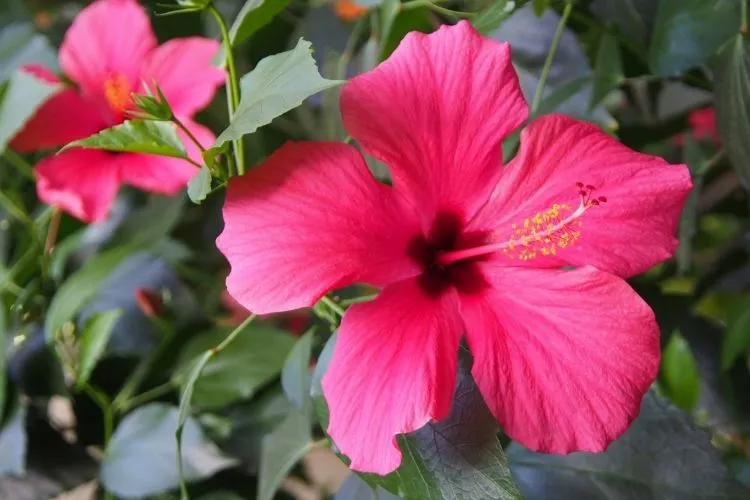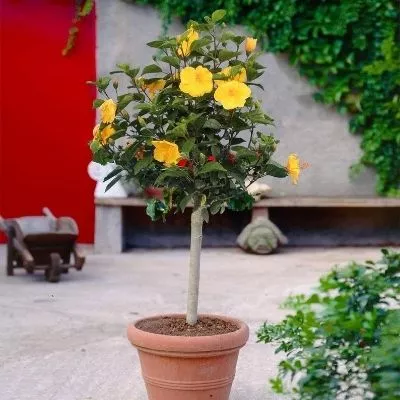Beautiful hibiscus plants come in hardy and tropical varieties, and hibiscus care in winter involves a few different steps depending on the variety you have.
If you’ve got one of these beauties in your garden and need to know what’s involved in caring for your hibiscus in winter, read on!
RELATED: Dahlias are another great option for adding show-stopping color to your flower garden. And with the right care, they’re perennial, too! Stop by our post to learn how to grow dahlias.
Table of Contents
Types of Hibiscus Plants
There are numerous species of hibiscus plants, but they all fall into two main categories.
- Hardy hibiscus
- Tropical hibiscus
You’ll also see hibiscus in tree form, but that’s actually not a separate type. (More on that a little later!)
Let’s talk about the different categories of hibiscus plants and what zones they thrive in. If you’re not sure which zone you’re in, consult this USDA reference map.
Hardy Hibiscus
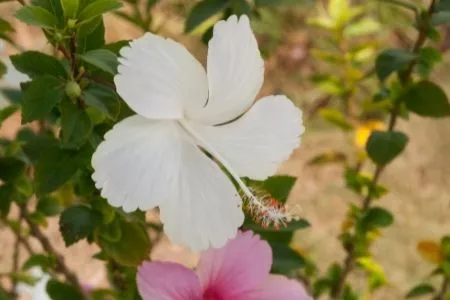
Hardy hibiscus is a low maintenance, easy-to-grow perennial that can handle cold winters and appear to come back from the dead after a punishing winter.
I have a friend whose mom has had a hardy hibiscus in her backyard for at least 30 years. Even though she lives in a mild, humid climate, her area had a super hard freeze (the first time in about 20 years!) that lasted almost a week.
The hibiscus appeared to die down to the ground. But about 3 months later, a bunch of leaves appeared and she is so relieved!
A hardy hibiscus is ideal for zones 5-10, and even zone 4 can grow it with protection.
Their flowers are large and dramatic in red, pink, white, and beautiful bi-color combinations. Some varieties can grow quite large, up to 10 feet wide and 12 feet tall!
They’re also a favorite with pollinators, and their colorful blooms will bring butterflies and hummingbirds to your garden.
Tropical Hibiscus
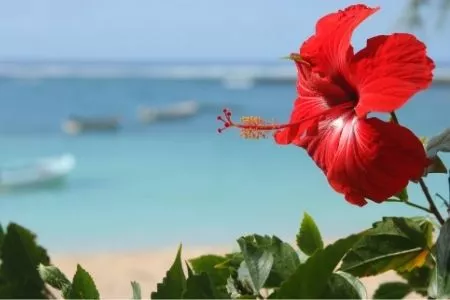
Tropical hibiscus varieties are native to Asia and can grow up to 2 feet per year and maxing out around 15 feet, as long as the conditions are right.
Its booms are anywhere from 3 to 8 inches in diameter with vibrant colors (sometimes multiple colors!) and protruding stamens.
Tropical hibiscus typically do very well in North America. In zones 9-11, these varieties can live outdoors all year long. In the lower zones, typically 5-8, tropical hibiscus can thrive in pots as long as you bring them indoors when the weather turns cold.
Hibiscus Trees
Hibiscus trees aren’t a true separate type of hibiscus; they are either tropical or hardy varieties that have been trained into a tree shape.
Your tree should max out at about the same height as an untrained hibiscus of the same variety, usually about 12-15 feet.
But that’s only if you have your tree in the ground. Many people keep their hibiscus trees in pots, which restricts their root expansion and therefore overall growth.
If your tree is in a pot, it will likely stay less than 7 feet tall.
You can prune and train any type of hibiscus into a tree form. There are a few different options of pre-trained hibiscus trees on Amazon, like from Costa Farms.
Just be aware that live plants ordered online could get damaged in shipping, even though most sellers package their plants with great care.
If you’re concerned about that issue at all, shopping for a hibiscus tree at your local greenhouses and nurseries may be a better option.
Hardy Hibiscus Winter Care
The outdoor hardy hibiscus will behave like a perennial in cold weather, meaning it will basically die down until only the root system and a few stems remain.
There are a few steps to caring for your hardy hibiscus in winter:
- Prune the plant back once the first frost arrives. You can either cut off old growth to a height of about 1 foot, or trim it down to the ground.
- Add mulch to the ground in a thick layer (at least a foot deep). Put those autumn leaves to good use here: Chop them finely with your lawnmower, and then heap them over your trimmed hibiscus.
- Water well before any cold temperatures occur.
That’s all the prep the hardy hibiscus takes!
These plants will go dormant during cold months, so sometimes it will look like they may have died.
Don’t fret! Just take the steps above and your hardy hibiscus should do just fine and reward you with blooms next summer.
Tropical Hibiscus Winter Care
If you live in a warm climate, your tropical hibiscus can stay outside all winter.
Growers in zones 10-11 should have no problems at all, and those in zone 9 should be ok unless the winter weather is unusually harsh.
In these warmer zones, tropical hibiscus will go dormant in the winter months, so only water when the soil feels dry. If there’s any danger that the temperature may fall below 50 degrees F, apply a layer of mulch around your plant, up to 4 inches deep.
You can do a little bit of pruning for shape only in the late summer, but save your full pruning plans until next spring.
Tropical hibiscus is not cold-hardy in the least. In the lower zones, (zones 4 – 8), it’s best to keep these plants in pots that you can bring inside over the winter.
Like this:
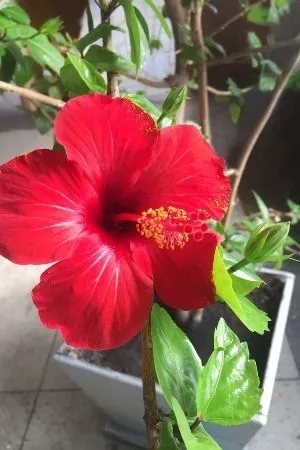
Take the following steps to overwinter your tropical hibiscus indoors:
Step 1: Prune. Cut your container-grown hibiscus down by about half, which really just makes it easier to bring indoors.
Do this at the end of summer or the beginning of fall.
Step 2: Container prep. Clean off any dirt from the outside of the pot because you don’t want that on your floors! Place a plant saucer underneath the container to catch any overflow water and soil that may escape.
Step 3: Pest removal. Make sure there are no pests by spraying the plant with water or neem oil. Preferably one specially formulated for flowering plants.
Step 4: Sunlight. Find a spot in the house that is warm and sunny, then bring your tropical hibiscus indoors before the first frost.
Step 4: Water. Your tropical hibiscus will likely not need as much water during the cold months. But don’t forget to water it when the soil is dry to the touch.
Follow all of these steps and your tropical hibiscus should be ready for spring once it gets warm again.
Hibiscus Tree Winter Care
Prepping your hibiscus tree for winter is based on whether it is hardy or tropical.
Light pruning is fine as long as it’s done from the bottom of the tree, and it’s mostly for ease of moving the container inside.
Let’s look at a few tips on hibiscus tree care in winter:
For hardy hibiscus varieties:
- If you’ve got your hardy hibiscus tree in a pot, you can leave it outside, but it will do best when placed next to an external wall of the house. This will give it a little bit of warmth when the temperatures get cold. You may even consider hanging some lights around it (not LED) for additional warmth as well.
- You may drape a tarp over your hardy hibiscus and add some mulch around the base for further protection from cold and freezing precipitation in the coldest zones.
- If your hardy hibiscus tree lives in the ground, apply the same 12-inch layer of mulch insulation that we talked about for hardy bushes.
For tropical hibiscus varieties:
- Those few days or weeks when the indoor temperature is the same as outdoor is the optimal time to move your tropical hibiscus tree indoors. This helps with preventing any shock.
- Be careful to remove or kill any pests before bringing your tropical hibiscus tree indoors, using the steps we outlined in the previous section.
- Place your hibiscus tree in direct sunlight indoors.
- High heat is not necessary for the indoor tropical hibiscus tree- it will be fine even with ambient temperatures at 55 degrees F.
- Water sparingly only when the soil is dry. Living indoors with a heater can dry the soil out quickly, so keep an eye on it!
Hibiscus tree winter care is much like other indoor houseplants. Just monitor the three categories (light, water, temperature) and it will thrive once spring hits!
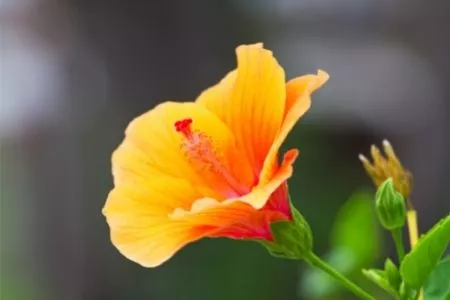
How to Care for Hibiscus After Winter
Hopefully your hibiscus plants have done just fine through the cold months indoors or outdoors with the tips listed above.
Now let’s discuss each type of hibiscus and the next steps to get them ready for spring!
Hardy Hibiscus
Once all danger of frost has passed, take off all of the mulch covering your hardy hibiscus.
Use an organic fertilizer to ensure healthy new growth and full, colorful blossoms.
Water about once a week, or when soil is dry. Then just wait (it’s hard to be patient, isn’t it?) and watch it come back to life!
Tropical Hibiscus
Once the outside temperatures are consistently above 50 degrees F (overnight temps too!), it’s safe to bring your tropical hibiscus plants back outside.
Trim off any dead leaves or branches and water if the soil is dry. Then place your tropical hibiscus in a sunny location and watch it come back to full bloom!
Hibiscus Trees
For hardy varieties that stayed outside all winter, remove the mulch after nighttime temperatures are above 50 degrees F.
Trim off any dead leaves and branches, and water just enough to moisten the soil.
For tropicals that overwintered indoors, bring them back outside after temperatures top 55 degrees F. Trim off any dead branches/foliage and give it a light watering.
Place your hibiscus tree in a sunny spot in your garden and watch it thrive again!
Frequently Asked Questions about Hibiscus Care in Winter
Final Thoughts
Hibiscus plant winter care takes just a little bit of time and effort, but that extra care pays off big time in the long run.
Whether you’ve got tropical or hardy variety, hibiscus is a beautiful, easy-to-grow perennial whose blooms just can’t be beat. It’s definitely worth your investment to enjoy those blooms again next year!
Did you find this article helpful? Share it with your friends on social media!

